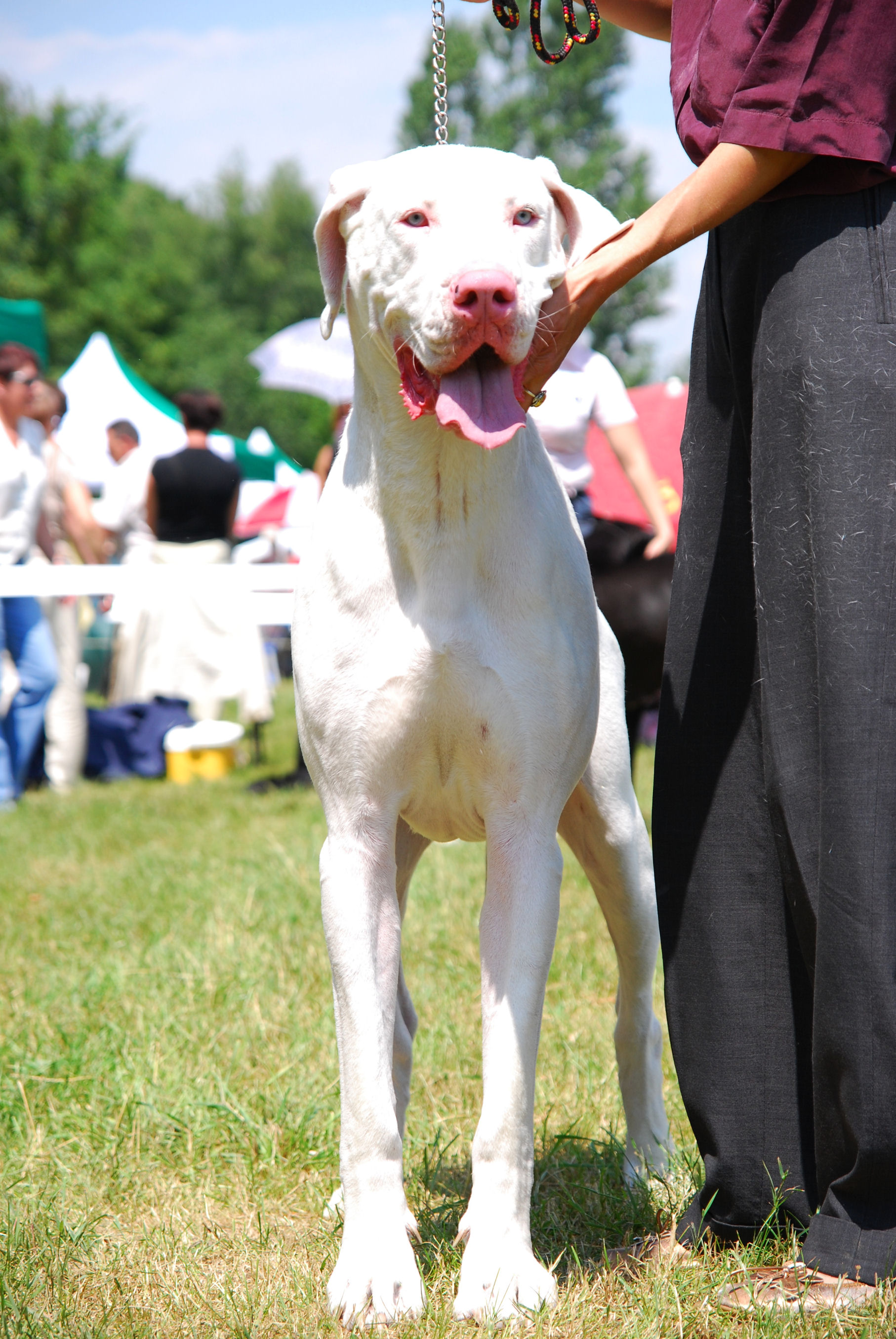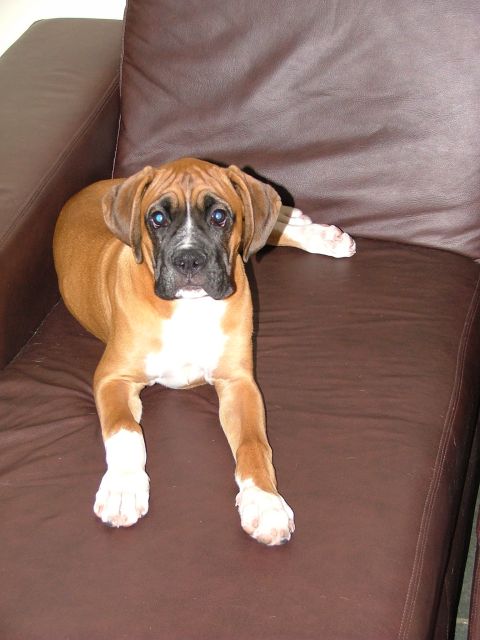I realized recently that when I post the Guess the Genotype posts not everyone may understand what the terms I use mean. For GtG I try to only use the scientifically proven genes. My favorite reference for this is a page kept by the
University of Saskatchewan, which has an ongoing project on canine color.
What this boils down to is that what a breed standard calls a color may not be what I will call the color. I am trying to refer to both terms, but these can often be quite different. The reason why terms vary so greatly between dog breeds is because the standards were written by completely different people at completely different times. Also, sometimes the layperson will misinterpret what a color actually is. Here are some examples.
"Red"
 |
| A "red" Doberman is actually liver and tan |
Red can refer to a wide variety of genotypes. In one breed it will be sable, another recessive red (also called clear red). These are usually what will be refereed to when you hear the term "red." Shade of red can vary from a deep mahogany like that of Irish Setters to the lighter yellow seen in Labradors. However, red can also refer to liver dogs. This is seen in breeds like the Doberman pinscher and the Australian shepherd. This can include dogs with or without tan markings (the phrase "red and tan" just sounds wrong to me) and/or merling. It can even be dogs with roaning or ticking, up to and including the extreme white piebald sable roan seen in Australian cattle dogs.
 |
| This "brown" mixed breed is actually a lightly masked sable |
"Brown"
Brown is a very similar conundrum to red. Though brown usually refers to the liver coloration (with or without tan markings) and that is what it should refer to in my opinion, it is sometimes also used to refer to sable or recessive red dogs. This can include sable with various skin pigment (usually black or liver) and dogs with or without black or the dilutes thereof in their coats (either as a mask or light sable overlay ).
 |
| "Blue" Aussies are extreme piebald black and tan with roaning |
"Blue"
In my opinion, the term "blue" is one of the worst offenders when it comes to what it can include. The term blue really should refer to the blue/dilution gene, which turns black in a coat to a slate gray color. However, it can also refer to dogs with the graying gene (born black and pale with age), black dogs with the merle gene, or black dogs with ticking or roaning (which are born black and white and darken with age). All of these various forms may also have tan points. The dog seen at right will have been born mostly white in color.
"Gray"
 |
| This "gray" Schnauzer is very pale red or "platinum" agouti |
This presents a similar problem to "blue." True gray is a dog with the graying gene (as I said, born black and lighten with age) that may occasionally have tan points. However, it is also used to refer to dogs that are blue or Isabella/fawn (which is the blue dilution + the liver dilution) and even sable or agouti dogs with very pale red (as in the "salt and pepper" dog at right).
"White"
 |
| This "white" Dane is a double merle harlequin |
White is also a term which can refer to numerous genotypes. It can be a dog that is a near white recessive red (which often have a cream tint and/or reddish ears), extreme white piebald (with or without small spots of color), or homozygous "double" merle (also with or without small spots of color). Double merle can have significant amounts of color, but can also be nearly all white. In Great Danes, the harlequin modifier (which removes the lighter gray color in merles) can create a dog very near solid white if the merle is distributed in such a way as to have very little black. Depending on genotype, dogs may or may not have pigment in their nose, lips, paw pads, and eye rims. Double merles are often deaf and/or blind. Extreme piebalds can occasionally be deaf. The dog at right may simply be a double merle or a minimally marked harlequin, but because of the complete absent of pigment to all parts of the dog's body, it is most likely a double merle harlequin.
"Fawn"
 |
| This "fawn" Boxer is masked sable carrying extreme piebald |
This term more properly refers to the Isabella coloration (which is blue + liver), but is also often used to refer to sable or recessive red dogs in the middle to light end of the shade range. This can include dogs with or without a mask or sable overlay.
This list is also not all-inclusive. There are numerous ways in which color terminology can be confusing. To avoid this, I am trying my best to be consistent so that the various GtG's can be more easily compared to one another.
All images are from Wikimedia Commons under creative commons licenses: one, two, three, four, five, six







I refuse to call red dobermans, border collies, and Australian shepherds "red." Liver is not red.
ReplyDeleteI even have issues with calling chocolate Labs by that name, but it is good advertising. Would you rather eat chocolate or liver?
All golden retrievers are recessive reds, even the so-called "white" ones. Well over 90 percent are black-skinned recessive reds. They just have different chinchilla modifiers. The genetic basis for chinchilla is all theoretical, of course.
I think one of the reasons why the brown skin gene was selected out of the golden retriever is that you can get liver flat-coats that look like very dark red dogs. When the two dogs were the same breed or could be interbred, breeding a misidentified red-hued liver to a black-skinned recessive will produce black puppies. So it would make sense that black skin in golden retrievers would have been preferred-- just to prevent confusion. Some golden retrievers remained within the flat-coated retriever registry, as strange as this sound, and there still are yellow flat-coats. The flat-coated retriever people have the color as a DQ in the standard.
That white Dane may be more than a double merle.
ReplyDeleteThe harlequin gene has recently been discovered, and it is just like merle-- a lethal semidominant.
Harlequins are not merle and piebald dogs as once was assumed. They are dogs with the Mm and the newly discovered Hh genotype. Homozygous for both is very bad for the dog.
http://www.gdca.org/health/breakingnews.htm
ReplyDeleteIt is said that all double harls are reabsorbed, but I am skeptical. They said the same thing about homozygous bobtail corgis, and they are sometimes born.
ReplyDeleteIt's not very common, but it happens.
Same with homozygous dominant hairless dogs, but these are even rarer.
From what I'm reading the white dane is a double merle with one copy the harlequin gene.
ReplyDeleteI agree with you for the term "red" and I also wish there was more consistency in general between breeds.
ReplyDeleteI am interested to see if they will identify the genes that control red intensity. From what I've seen, there are two or three different theories as to what controls it, each using different letters to represent the different shades.
Yellow flats coats look very interesting. http://www.chathamhilldogs.com/Yellow_Flat-Coat_Owners.html
They're a bit like rangy goldens!
I am aware of the recent discovery of the harlequin gene. I wonder if there will one day be an extensive genetic study to determine if double harlequins are present in the breed? It would be intriguing to see the results.
I agree with you that the dog I featured is probably Hh MM. I completely forgot to mention the gene and I'll being going through and adding it right now.